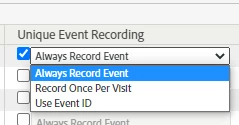Text Values for Events
Hello,
If I register an event
event1=fizzbuzzon a click, and later on a different click,
event1=buzzfizzwill I get metrics for each value passed in the event? Is that how the text string option works?
Thanks.
mp
Hello,
If I register an event
event1=fizzbuzzon a click, and later on a different click,
event1=buzzfizzwill I get metrics for each value passed in the event? Is that how the text string option works?
Thanks.
mp
Hi,
I am going to assume you are asking about event id serialization? (https://experienceleague.adobe.com/docs/analytics/implementation/vars/page-vars/events/event-serialization.html?lang=en)
Events are counters, they aren't "text", but you can append text, not with an equals (=) sign, but with a colon (:).

To "always" record the event, to record once per visit, or once per unique id passed. This is handy for tracking things like user registrations where you are afraid the user may refresh the page, or go backwards and trigger multiple times, or for things like purchases/subscriptions/etc that have a unique reference code)
If you are trying to get events counted per "value" (i.e. buzzfizz got 140, and fizzbuzz got 97) then there are a few ways to go...
IF on the trigger you will only every have one value, you can just use a prop or evar to hold the value. Then in your reports you can use your event1 metric and breakdown by your prop or evar to get the counts per value.
IF your trigger is passing multiple values, but the counts are always 1 per... then you can use a prop (set up as a list variable) or use one of your three list variables to pass each of the values you want counted, and just like above, use your event1 metric and break down by your dimension to get your individual counts.
IF your trigger is passing multiple values and the counts are different per value, this gets complicated (not impossible, I do this frequently) to make sure that the count but it does require using your one and only s.product (yes this is technically supposed to be use for shopping cart purchases, but it's the ability to explicitly connect a metric (with a specific counter) to a value (without impacting the other value)...
For instance (and sorry for the code if you aren't familiar)
[optionalCat];buzzfizz;;;event1=2,[optionalCat];fizzbuzz;;;event1=1
in this case, buzzfizz will be given a count of 2 while fizzbuzz will only get a count of 1 (separate counts for separate values). In this case, the event1 must be configured to be numerical (not a counter), so that it will take the = notation to pass a specific value
Enter your E-mail address. We'll send you an e-mail with instructions to reset your password.